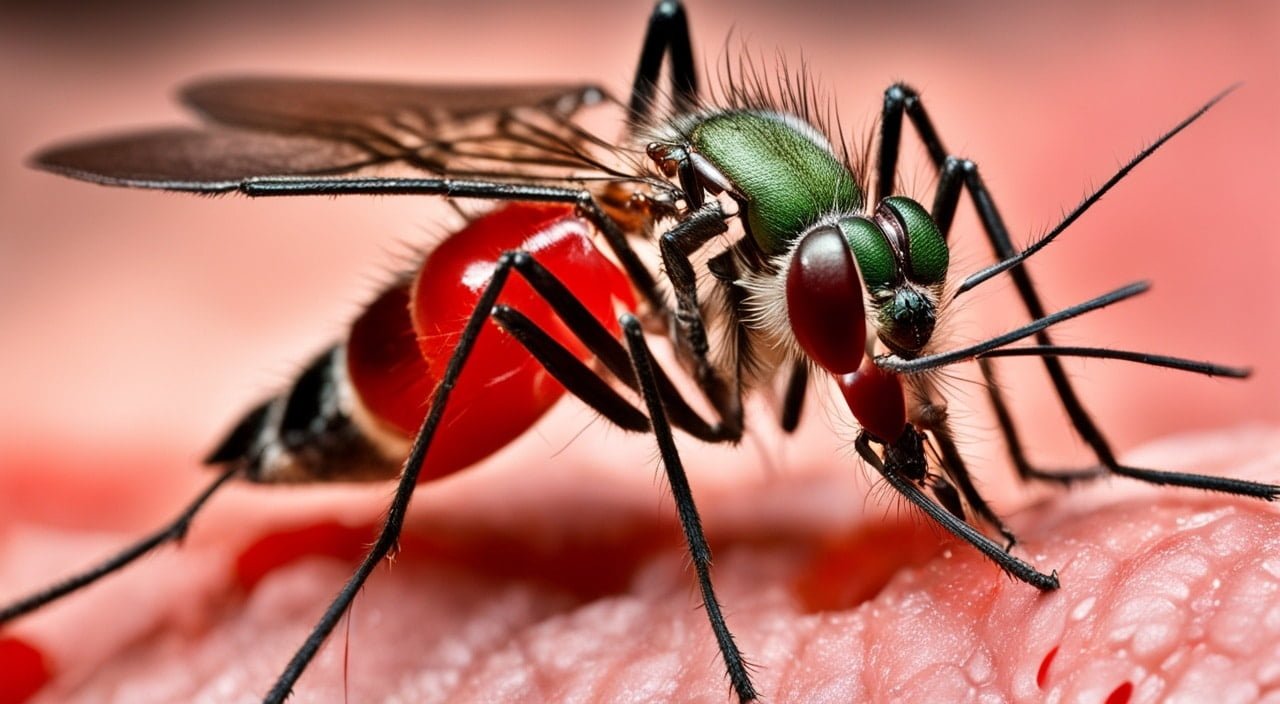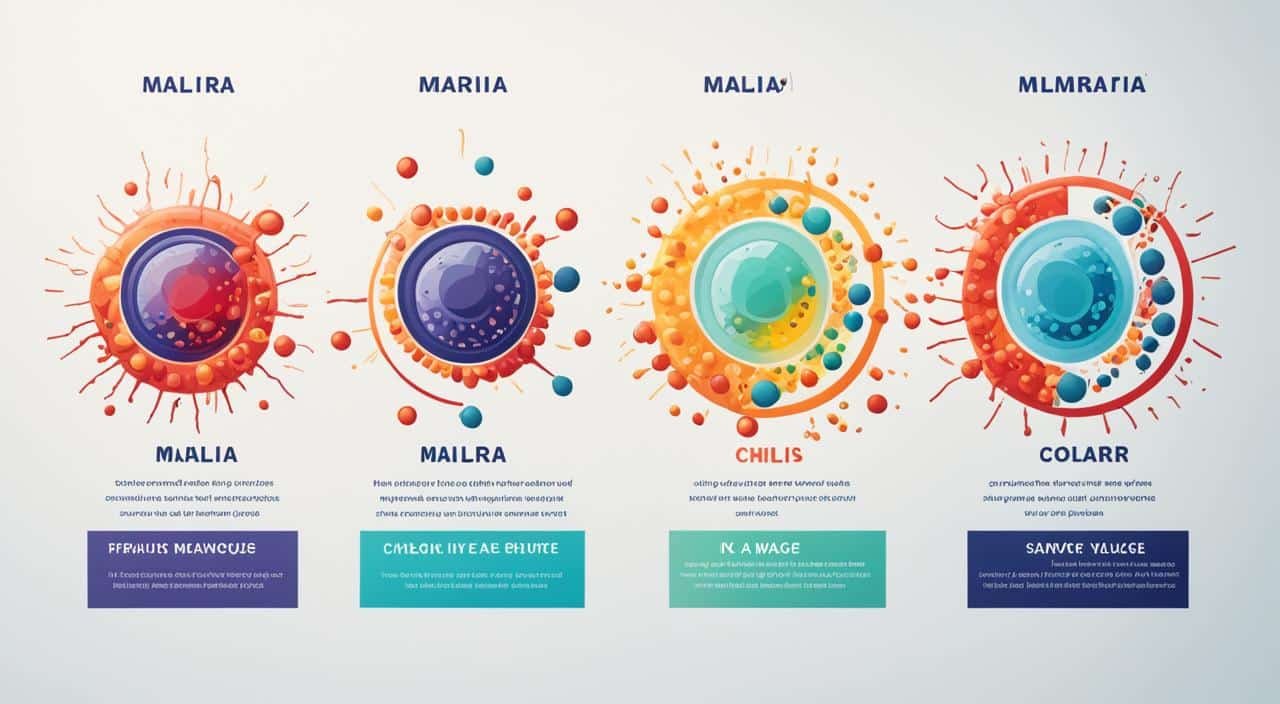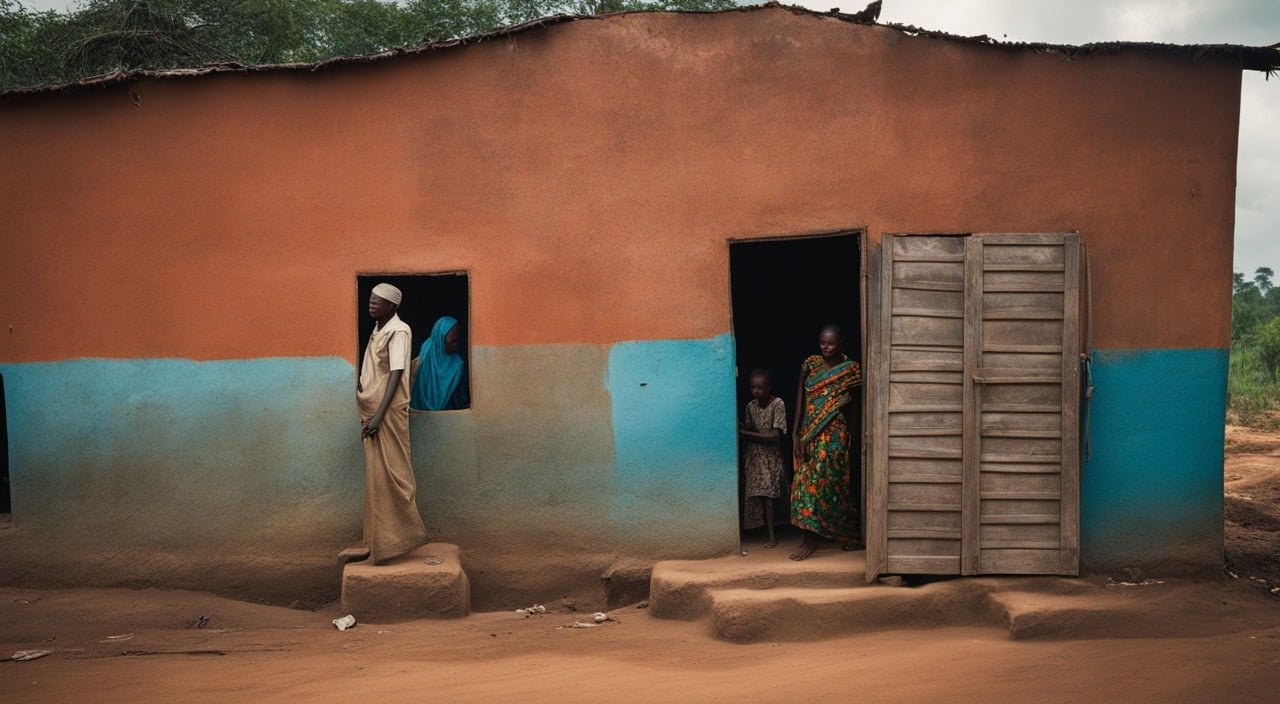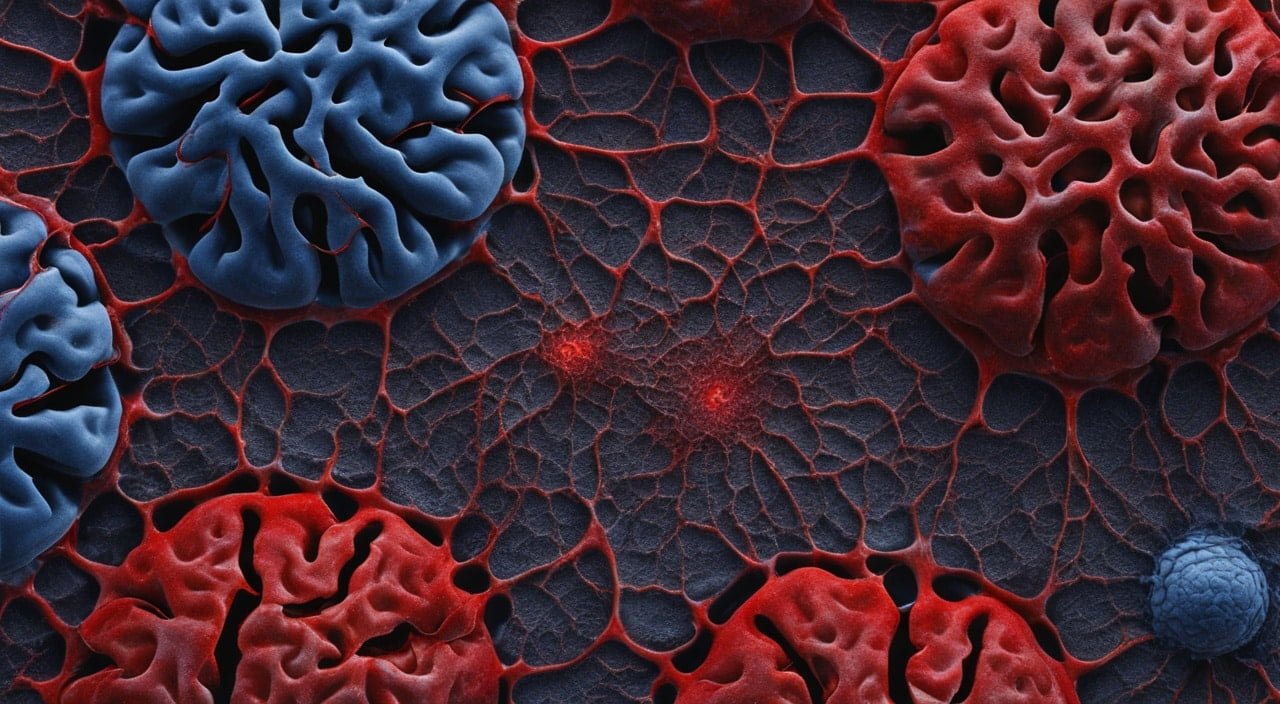Malaria is a serious disease caused by a parasite spread through mosquito bites. Symptoms show up a few weeks after the bite and can vary. They include fever, chills, headache, nausea, and feeling very tired.
In severe cases, malaria can cause brain swelling, seizures, and even coma. It’s important to know the symptoms to get help quickly.
Key Takeaways
- Malaria is a serious infectious disease caused by a parasite transmitted through infected mosquito bites
- Common symptoms include fever, chills, headache, nausea, and fatigue
- Severe cases can lead to complications like cerebral malaria, which can be life-threatening
- Prompt diagnosis and treatment are crucial to prevent serious complications and reduce the risk of death
- Preventive measures like using insect repellent and taking antimalarial medications are important for those traveling to areas where malaria is common
What is Malaria?
Malaria is a serious disease caused by a tiny parasite called Plasmodium. It spreads through bites from infected female Anopheles mosquitoes. This disease is a big health issue in tropical and subtropical areas, especially in Africa and South Asia.
Definition and Overview
Malaria is a major health problem worldwide, affecting millions yearly. It makes people very sick with symptoms like fever, chills, and headaches. If not treated, it can lead to serious problems, including organ failure and death.
Causes of Malaria
Malaria comes from a tiny parasite in the Plasmodium genus. It spreads mainly through bites from infected mosquitoes. When an infected mosquito bites someone, it gives the parasite to the person.
This parasite then moves to the liver, multiplies, and infects red blood cells. This causes the symptoms of malaria. Sometimes, the parasites can stay in the liver for years, causing the disease to come back later.
“Malaria is a serious infectious disease that affects millions of people worldwide each year.”
Also Read : What Are The Types Of Medical Technology?
Malaria Transmission

Malaria spreads mainly through the bites of infected female Anopheles mosquitoes. This cycle starts when a mosquito bites an infected person and picks up the malaria parasites. These parasites then grow inside the mosquito and move to its salivary glands.
When the mosquito bites another person, it injects the parasites into the bloodstream. This begins the infection cycle. The parasites move to the liver, grow, and then infect the red blood cells, causing malaria symptoms.
Also Read :Are There Any Side Effects Of The Yellow Fever Vaccine?
Other Modes of Transmission
Malaria can also spread through ways other than mosquito bites. It can be passed from a pregnant woman to her baby during pregnancy or at birth. Transmission can also happen through blood transfusions or sharing needles for drugs.
But these ways are much less common than getting it from mosquitoes. Mosquito-borne transmission is by far the main cause of malaria worldwide.
| Transmission Method | Frequency |
|---|---|
| Mosquito Bites | Most Common |
| Mother-to-Child | Less Common |
| Blood Transfusion | Rare |
| Needle Sharing (Drug Use) | Rare |
Common Symptoms of Malaria

Malaria is a serious illness that can be life-threatening. It’s important to know its symptoms to get help fast. The main symptoms are:
- Fever – Malaria often causes a high fever that can hit up to 104°F (40°C).
- Chills – Feeling cold and shivering is common, especially at the start.
- Headache – People with malaria often have severe headaches.
- Nausea and vomiting – You might feel sick to your stomach, vomit, or have diarrhea.
- Fatigue – Malaria makes you extremely tired and weak.
- Muscle and joint pain – You might feel pain all over your body.
Some people get “attacks” with malaria. These start with shivering and chills, then a high fever, and end with sweating and normal temperature. Other signs include fast breathing, a fast heart rate, and a dry cough.
Symptoms usually show up a few weeks after a mosquito bite. But sometimes, the parasites can hide in the liver for up to a year before causing an infection.
| Symptom | Description |
|---|---|
| Fever | High, cyclical fever that can reach up to 104°F (40°C) or higher |
| Chills | Shivering and feeling extremely cold |
| Headache | Severe and persistent headaches |
| Nausea and vomiting | Stomach upset, including nausea, vomiting, and sometimes diarrhea |
| Fatigue | Extreme tiredness and lack of energy |
| Muscle and joint pain | Widespread aches and pains throughout the body |
| Rapid breathing | Faster than normal breathing rate |
| Rapid heart rate | Faster than normal heart rate |
| Dry cough | A persistent, dry cough |
Knowing these symptoms is key to getting help fast. Malaria can be very dangerous if not treated right away.
Also Read : What Types Of Skin Cancer Can Be Treated With Natural Remedies?
When to See a Doctor
If you get a fever after being in or visiting a high-risk region for malaria, see a doctor right away. Malaria is a serious illness that can be deadly. Getting help quickly is key to getting better.
Signs that mean you need emergency medical attention include trouble breathing, organ failure, or changes in how you think. Spotting these signs early and getting help fast can really help you recover.
- Get medical care quickly if you have a fever and have been to a high-risk malaria region.
- Call for emergency medical attention if you have severe symptoms like trouble breathing, organ failure, or changes in how you think.
- Quick action and the right treatment are very important for fighting malaria and preventing serious problems.
“Early recognition of malaria symptoms and timely medical intervention can significantly improve the chances of a successful recovery.”
Being careful and getting medical care fast can really help you get better. It can also stop serious problems from happening with malaria.
Risk Factors for Malaria

Living in or visiting places where malaria is common is the main risk factor. This includes tropical and subtropical areas. High-risk zones are mainly in sub-Saharan Africa, South and Southeast Asia, the Pacific Islands, Central America, and northern South America. The risk can change based on local efforts to control malaria, the time of year, and how well you protect yourself from mosquito bites.
People who visit these areas, especially those new to malaria, are more likely to get the disease.
Groups at Higher Risk
Some groups are more at risk of severe malaria complications, including:
- Young children and infants
- Older adults
- Travelers from non-endemic areas
- Pregnant women and their unborn children
In many places with high malaria rates, getting preventive measures, medical care, and information is hard. People living in malaria-endemic areas may get some immunity, but this can decrease if they move away and are no longer often exposed to the parasite.
Also Read :What Foods Should You Eat If You Have Diabetes?
Areas with High Malaria Rates
The places with the most malaria are in tropical and subtropical climates. This is where the mosquitoes that spread the disease live. These high-risk areas include:
- Sub-Saharan Africa
- South and Southeast Asia
- Pacific Islands
- Central America
- Northern South America
The chance of getting malaria in these areas depends on local efforts to control it, the season, and how well you protect yourself from mosquitoes. Travelers to these places, especially those new to the disease, are at a higher risk of getting malaria.
Potential Complications of Malaria

Malaria is a serious disease that can be deadly if not treated. Cerebral malaria is a dangerous form that happens when parasites block blood vessels in the brain. This can cause swelling, seizures, coma, and even brain damage.
Other serious problems from malaria include:
- Breathing problems: Malaria can cause fluid to build up in the lungs, making it hard to breathe.
- Organ failure: It can harm organs like the kidneys, liver, and spleen, leading to failure and possibly death.
- Severe anemia: Malaria can reduce red blood cells, causing anemia that is life-threatening.
- Low blood sugar: It can lead to hypoglycemia, or very low blood sugar, which can be deadly.
If not treated quickly, malaria can be deadly, especially the type caused by Plasmodium falciparum. This parasite is common in Africa. It’s important to recognize and treat these problems early to prevent serious outcomes or death.
“Malaria is a life-threatening disease caused by parasites that are transmitted to people through the bites of infected mosquitoes. If not treated promptly, it can lead to severe complications and even death.”
Also Read :What Are The Types Of Stroke?
Preventive Measures Against Malaria

Stopping malaria needs a strong plan. One key step is to prevent mosquito bites. By avoiding infected mosquitoes, people can lower their risk of getting this serious disease.
Avoiding Mosquito Bites
To prevent malaria, cover your skin and use repellents. Wear long pants, shirts, and socks to protect against mosquito bites. Also, repellents with DEET, picaridin, IR3535, oil of lemon eucalyptus (OLE), or para-menthane-3,8-diol (PMD) can keep mosquitoes away.
Using bed nets treated with insecticides like permethrin can also block mosquitoes. This helps stop malaria from spreading.
Preventive Medications
People going to places where malaria is common might need preventive medications. These are also called antimalarial drugs or prophylaxis. The right drug and amount depends on where you’re going, how long you’ll stay, and your health. Always talk to a doctor before traveling to find out what preventive medication you need. Some malaria parasites don’t respond to certain drugs.
Using preventive medications correctly can greatly lower the chance of getting malaria in high-risk areas.
Malaria Diagnosis and Treatment

Finding out if someone has malaria is key to fighting it. Doctors use laboratory tests to check for Plasmodium parasites in blood. They look for these parasites using blood smears and rapid diagnostic tests. Blood smears are when a doctor looks at blood under a microscope. Rapid tests are quick ways to find certain malaria antigens.
After finding out someone has malaria, doctors give them the right antimalarial drugs. The treatment depends on the type of malaria, how bad it is, and if the drugs won’t work well. It’s very important to start treatment right away to stop serious problems and help the patient get better.
| Diagnostic Method | Description | Advantages |
|---|---|---|
| Blood Smear | Examination of a patient’s blood sample under a microscope to detect the presence of malaria parasites | Accurate identification of the parasite species, can provide information about the stage of the infection |
| Rapid Diagnostic Test (RDT) | Quick test that detects specific malaria antigens in a small blood sample | Fast results, can be performed in resource-limited settings, does not require specialized equipment |
Getting the right malaria treatment on time is very important. Doctors think about the type of malaria, how bad it is, and if the drugs won’t work well. Finding out early and starting treatment fast helps stop serious problems and helps the patient get better.
“Malaria is a major global health challenge, and accurate diagnosis and effective treatment are critical to reducing its burden. By leveraging both traditional and innovative diagnostic methods, we can ensure that patients receive the appropriate care and support their recovery.”
Global Impact and Burden of Malaria

Malaria is a big health issue worldwide, with 241 million cases and 627,000 deaths in 2020. It hits hardest in Africa and South Asia, where it’s common.
In sub-Saharan Africa, most malaria cases and deaths happen. Young kids under 5 are hit the hardest. They make up over 80% of deaths in Africa, showing how big a problem malaria is for them.
Malaria also hurts the economy, especially in poor areas with little healthcare. It keeps people sick and poor, making it hard for areas to get better.
“Malaria is a preventable and treatable disease, yet it continues to claim hundreds of thousands of lives each year, mainly among young children in Africa.”
Stopping malaria is a key health goal. We need to work on prevention, finding the disease early, and treating it right. By tackling the disease’s causes and improving healthcare access, we can aim to wipe out malaria.
Also Read: Optimizing Health with Functional Medicine Approach
Conclusion
Malaria is a serious disease that can be deadly. It’s a big health problem worldwide. The disease spreads through mosquitoes in warm parts of the world, especially in Africa and Asia.
Symptoms include fever, chills, headaches, and feeling very tired. If not treated, it can cause serious health issues or even death.
To prevent malaria, use insect repellent and sleep under treated bed nets. Taking antimalarial drugs is also important if you’re in an area where malaria is common. Getting diagnosed and treated early can help prevent serious problems.
Stopping malaria is a big health goal. We need to use many strategies to fight it. This includes preventing it, controlling it, and working to eliminate it completely.
We all need to be careful and work together to fight malaria. By spreading the word, using prevention methods, and getting timely treatment, we can lessen malaria’s effects. Let’s join forces to tackle this tough disease.
FAQs
Q: What are the common symptoms of malaria?
A: The common symptoms of malaria include fever, chills, headache, muscle aches, fatigue, nausea, and vomiting.
Q: How is malaria diagnosed?
A: Malaria is diagnosed through blood tests, such as a microscopic examination of blood smears or rapid diagnostic tests (RDTs).
Q: Is there a vaccine available for malaria?
A: Yes, there is a malaria vaccine called RTS,S/AS01 (brand name Mosquirix) approved for use in some African countries.
Q: What are the ways to prevent malaria?
A: Prevention of malaria includes using insect repellent, sleeping under mosquito nets, taking antimalarial medications, and eliminating mosquito breeding grounds.
Q: What is the treatment for malaria?
A: The treatment for malaria involves antimalarial medications prescribed by a healthcare provider based on the type of malaria parasite and the severity of the infection.
Q: How does malaria spread?
A: Malaria is transmitted through the bite of an infected female Anopheles mosquito carrying the malaria parasite.
Q: What are the risk factors for malaria?
A: Risk factors for malaria include traveling to areas where malaria is prevalent, lack of proper mosquito protection measures, and living in regions with high malaria transmission rates.
Source Links
- https://stanfordhealthcare.org/medical-conditions/primary-care/malaria/symptoms.html
- https://my.clevelandclinic.org/health/diseases/15014-malaria
- https://www.mayoclinic.org/diseases-conditions/malaria/symptoms-causes/syc-20351184




